Dynamic Multi-View Coupled Graph Convolution Network for Urban Travel Demand Forecasting
Abstract
:1. Introduction
- (1)
- The influence of spatial and temporal features. Between different areas of the city, the urban travel demand of geographically adjacent areas is easily influenced by each other. As shown in Figure 1, in two adjacent areas, such as the residential area and shopping area, the traffic flow has some similarities. The two areas have similar road and business district functions; then at the same time, the demand for taxis in these two areas tends to be similar even if they are geographically distant from each other. For example, if schools are uniformly dismissed at 5 p.m., the demand for taxi rides in the areas near each school will rise significantly and show some similarity. Urban road traffic network and main roads also have a direct impact on the size of the demand. The higher the density of the urban road networks is, with more main roads and larger the road area, the higher the service area and level of operating vehicles will be, and the demand for vehicles from urban residents will increase accordingly.
- (2)
- The influence of external features. Some external factors, such as heavy rain, snow, and holidays impact traffic demand. Figure 2, shows that people’s travel demand is higher in sunny weather than in rainy or snowy weather, etc. In Figure 2, it can be seen that people’s travel demand is higher in weather with suitable temperatures than when the temperature is too high or too low. In addition, people’s demand is also influenced by holidays; for example, people will gather in some commercial areas to celebrate the New Year, and the demand will rise on the New Year compared with weekdays. For this reason, this paper also considers the influence of weather and holidays.
- We propose an urban travel demand forecasting framework based on a dynamic multi-view coupled graph convolutional network, which is able to model the complex spatio-temporal relationships in travel demand data from multiple perspectives.
- We propose a method of dynamic demand similarity graph, then fuse geographic similarity graph, functional similarity graph, and road similarity graph to model the dynamic spatio-temporal associations in traffic.
- We conduct experiments on two real datasets, and the results verify the superior performance of our proposed approach compared with state-of-the-art models.
2. Related Work
2.1. Spatio-Temporal Correlation
2.2. Urban Travel Demand Forecasting
3. Preliminaries
4. Methodology
4.1. DMV-GCN Model
4.2. Graph Generation
4.3. Spatial Correlation Extraction
4.4. Temporal Correlation Extraction
5. Experiments
5.1. Datasets
5.2. Experiment Settings
- RMSE: It is used to measure the deviation between the predicted value and the true value, defined as:
- MAE: It is used to measure the mean of absolute error, defined as:
- MAPE: It is used to measure the percentage of predicted value to true value, defined as:
- HA: The historical average of the predicted time step is used as the predicted value.
- VAR: Vector autoregression for time series forecasting.
- ARIMA: Combining autoregressive and moving average models for time series forecasting.
- Graph WaveNet [29]: Graph convolution with adaptive adjacency matrices combines graph convolution operations and null causal convolution.
- StemGNN [37]: A spectroscopic time map neural network that jointly captures inter-sequence correlations and time dependence in the spectral domain.
- AGCRN [38]: Adaptive graphs are used to learn GRU in combination with graph convolution and node adaptive parameter learning.
- DGCRN [15]: The dynamic adjacency matrix is progressively generated from the hypernetwork, iterating in parallel with the RNN.
5.3. Visualization
6. Conclusions
Author Contributions
Funding
Institutional Review Board Statement
Informed Consent Statement
Data Availability Statement
Conflicts of Interest
References
- Han, X.; Shen, G.; Yang, X.; Kong, X. Congestion recognition for hybrid urban road systems via digraph convolutional network. Transp. Res. Part Emerg. Technol. 2020, 121, 102877. [Google Scholar] [CrossRef]
- Kong, X.; Zhu, B.; Shen, G.; Chekole Workneh, T.; Ji, Z.; Chen, Y.; Liu, Z. Spatial-Temporal-Cost Combination based Taxi Driving Fraud Detection for Collaborative Internet of Vehicles. IEEE Trans. Ind. Inform. 2021, 18, 3426–3436. [Google Scholar] [CrossRef]
- Cetin, M.; Comert, G. Short-term traffic flow prediction with regime switching models. Transp. Res. Rec. 2006, 1965, 23–31. [Google Scholar] [CrossRef]
- Chen, C.; Hu, J.; Meng, Q.; Zhang, Y. Short-time traffic flow prediction with ARIMA-GARCH model. In Proceedings of the 2011 IEEE Intelligent Vehicles Symposium (IV), Baden-Baden, Germany, 5–9 June 2011; pp. 607–612. [Google Scholar]
- Moreira-Matias, L.; Gama, J.; Ferreira, M.; Mendes-Moreira, J.; Damas, L. Predicting taxi–passenger demand using streaming data. IEEE Trans. Intell. Transp. Syst. 2013, 14, 1393–1402. [Google Scholar] [CrossRef] [Green Version]
- Ihler, A.; Hutchins, J.; Smyth, P. Adaptive event detection with time-varying poisson processes. In Proceedings of the 12th ACM SIGKDD International Conference on Knowledge Discovery and Data Mining, Philadelphia, PA, USA, 20–23 August 2006; pp. 207–216. [Google Scholar]
- Zhang, L.; Liu, Q.; Yang, W.; Wei, N.; Dong, D. An improved k-nearest neighbor model for short-term traffic flow prediction. Procedia-Soc. Behav. Sci. 2013, 96, 653–662. [Google Scholar] [CrossRef] [Green Version]
- Wu, Y.; Tan, H.; Qin, L.; Ran, B.; Jiang, Z. A hybrid deep learning based traffic flow prediction method and its understanding. Transp. Res. Part Emerg. Technol. 2018, 90, 166–180. [Google Scholar] [CrossRef]
- Wu, Y.; Tan, H. Short-term traffic flow forecasting with spatial-temporal correlation in a hybrid deep learning framework. arXiv 2016, arXiv:1612.01022. [Google Scholar]
- Liao, B.; Zhang, J.; Wu, C.; McIlwraith, D.; Chen, T.; Yang, S.; Guo, Y.; Wu, F. Deep sequence learning with auxiliary information for traffic prediction. In Proceedings of the24th ACM SIGKDD International Conference on Knowledge Discovery & Data Mining, London, UK, 19–23 August 2018; pp. 537–546. [Google Scholar]
- Du, B.; Hu, X.; Sun, L.; Liu, J.; Qiao, Y.; Lv, W. Traffic demand prediction based on dynamic transition convolutional neural network. IEEE Trans. Intell. Transp. Syst. 2020, 22, 1237–1247. [Google Scholar] [CrossRef]
- Li, Y.; Yu, R.; Shahabi, C.; Liu, Y. Diffusion convolutional recurrent neural network: Data-driven traffic forecasting. arXiv 2017, arXiv:1707.01926. [Google Scholar]
- Tang, J.; Liang, J.; Liu, F.; Hao, J.; Wang, Y. Multi-community passenger demand prediction at region level based on spatio-temporal graph convolutional network. Transp. Res. Part Emerg. Technol. 2021, 124, 102951. [Google Scholar] [CrossRef]
- Zhao, L.; Song, Y.; Zhang, C.; Liu, Y.; Wang, P.; Lin, T.; Deng, M.; Li, H. T-gcn: A temporal graph convolutional network for traffic prediction. IEEE Trans. Intell. Transp. Syst. 2019, 21, 3848–3858. [Google Scholar] [CrossRef] [Green Version]
- Li, F.; Feng, J.; Yan, H.; Jin, G.; Jin, D.; Li, Y. Dynamic graph convolutional recurrent network for traffic prediction: Benchmark and solution. arXiv 2021, arXiv:2104.14917. [Google Scholar] [CrossRef]
- Chai, D.; Wang, L.; Yang, Q. Bike flow prediction with multi-graph convolutional networks. In Proceedings of the26th ACM SIGSPATIAL International Conference on Advances in Geographic Information Systems, Seattle, WA, USA, 6–9 November 2018; pp. 397–400. [Google Scholar]
- Jin, G.; Cui, Y.; Zeng, L.; Tang, H.; Feng, Y.; Huang, J. Urban ride-hailing demand prediction with multiple spatio-temporal information fusion network. Transp. Res. Part Emerg. Technol. 2020, 117, 102665. [Google Scholar] [CrossRef]
- Geng, X.; Li, Y.; Wang, L.; Zhang, L.; Yang, Q.; Ye, J.; Liu, Y. Spatiotemporal multi-graph convolution network for ride-hailing demand forecasting. In Proceedings of the AAAI Conference On Artificial Intelligence, Honolulu, HI, USA, 27 January–1 February 2019; Volume 33, pp. 3656–3663. [Google Scholar]
- Li, Y.; Lu, J.; Zhang, L.; Zhao, Y. Taxi booking mobile app order demand prediction based on short-term traffic forecasting. Transp. Res. Rec. 2017, 2634, 57–68. [Google Scholar] [CrossRef]
- Kong, X.; Duan, G.; Hou, M.; Shen, G.; Wang, H.; Yan, X.; Collotta, M. Deep Reinforcement Learning based Energy Efficient Edge Computing for Internet of Vehicles. IEEE Trans. Ind. Inform. 2022, 18, 6308–6316. [Google Scholar] [CrossRef]
- Zhou, X.; Shen, Y.; Zhu, Y.; Huang, L. Predicting multi-step citywide passenger demands using attention-based neural networks. In Proceedings of the Eleventh ACM International Conference on Web Search and Data Mining, Los Angeles, CA, USA, 5–9 February 2018; pp. 736–744. [Google Scholar]
- Ke, J.; Yang, H.; Zheng, H.; Chen, X.; Jia, Y.; Gong, P.; Ye, J. Hexagon-based convolutional neural network for supply-demand forecasting of ride-sourcing services. IEEE Trans. Intell. Transp. Syst. 2018, 20, 4160–4173. [Google Scholar] [CrossRef]
- Song, C.; Lin, Y.; Guo, S.; Wan, H. Spatial-temporal synchronous graph convolutional networks: A new framework for spatial-temporal network data forecasting. In Proceedings of the AAAI Conference on Artificial Intelligence, New York, NY, USA, 7–12 February 2020; Volume 34, pp. 914–921. [Google Scholar]
- Zhang, Q.; Chang, J.; Meng, G.; Xiang, S.; Pan, C. Spatio-temporal graph structure learning for traffic forecasting. In Proceedings of the AAAI Conference on Artificial Intelligence, New York, NY, USA, 7–12 February 2020; Volume 34, pp. 1177–1185. [Google Scholar]
- Wang, Y.; Fang, S.; Zhang, C.; Xiang, S.; Pan, C. TVGCN: Time-variant graph convolutional network for traffic forecasting. Neurocomputing 2022, 471, 118–129. [Google Scholar] [CrossRef]
- Kong, X.; Chen, Q.; Hou, M.; Rahim, A.; Ma, K.; Xia, F. RMGen: A Tri-Layer Vehicular Trajectory Data Generation Model Exploring Urban Region Division and Mobility Pattern. IEEE Trans. Veh. Technol. 2022. [Google Scholar] [CrossRef]
- Zhang, J.; Zheng, Y.; Qi, D.; Li, R.; Yi, X.; Li, T. Predicting citywide crowd flows using deep spatio-temporal residual networks. Artif. Intell. 2018, 259, 147–166. [Google Scholar] [CrossRef] [Green Version]
- Feng, S.; Ke, J.; Yang, H.; Ye, J. A multi-task matrix factorized graph neural network for co-prediction of zone-based and OD-based ride-hailing demand. IEEE Trans. Intell. Transp. Syst. 2021, 23, 5704–5716. [Google Scholar] [CrossRef]
- Wu, Z.; Pan, S.; Long, G.; Jiang, J.; Zhang, C. Graph wavenet for deep spatial-temporal graph modeling. In Proceedings of the 28th International Joint Conference on Artificial Intelligence, Macao, China, 10–16 August 2019; pp. 1907–1913. [Google Scholar]
- Yang, X.; Zhu, Q.; Li, P.; Chen, P.; Niu, Q. Fine-grained predicting urban crowd flows with adaptive spatio-temporal graph convolutional network. Neurocomputing 2021, 446, 95–105. [Google Scholar] [CrossRef]
- Ye, J.; Sun, L.; Du, B.; Fu, Y.; Xiong, H. Coupled layer-wise graph convolution for transportation demand prediction. In Proceedings of the AAAI Conference on Artificial Intelligence, Virtually, 2–9 February 2021; Volume 35, pp. 4617–4625. [Google Scholar]
- Lin, J. Divergence measures based on the Shannon entropy. IEEE Trans. Inf. Theory 1991, 37, 145–151. [Google Scholar] [CrossRef] [Green Version]
- Shen, G.; Zhu, D.; Chen, J.; Kong, X. Motif discovery based traffic pattern mining in attributed road networks. Knowl. Based Syst. 2022, 250, 109035. [Google Scholar] [CrossRef]
- Liu, L.; Zhen, J.; Li, G.; Zhan, G.; He, Z.; Du, B.; Lin, L. Dynamic spatial-temporal representation learning for traffic flow prediction. IEEE Trans. Intell. Transp. Syst. 2020, 22, 7169–7183. [Google Scholar] [CrossRef]
- Pian, W.; Wu, Y.; Qu, X.; Cai, J.; Kou, Z. Spatial-temporal dynamic graph attention networks for ride-hailing demand prediction. arXiv 2020, arXiv:2006.05905. [Google Scholar]
- Shen, G.; Zhao, Z.; Kong, X. GCN2CDD: A commercial district discovery framework via embedding space clustering on graph convolution networks. IEEE Trans. Ind. Inform. 2021, 18, 356–364. [Google Scholar] [CrossRef]
- Cao, D.; Wang, Y.; Duan, J.; Zhang, C.; Zhu, X.; Huang, C.; Tong, Y.; Xu, B.; Bai, J.; Tong, J.; et al. Spectral temporal graph neural network for multivariate time-series forecasting. Adv. Neural Inf. Process. Syst. 2020, 33, 17766–17778. [Google Scholar]
- Bai, L.; Yao, L.; Li, C.; Wang, X.; Wang, C. Adaptive graph convolutional recurrent network for traffic forecasting. Adv. Neural Inf. Process. Syst. 2020, 33, 17804–17815. [Google Scholar]
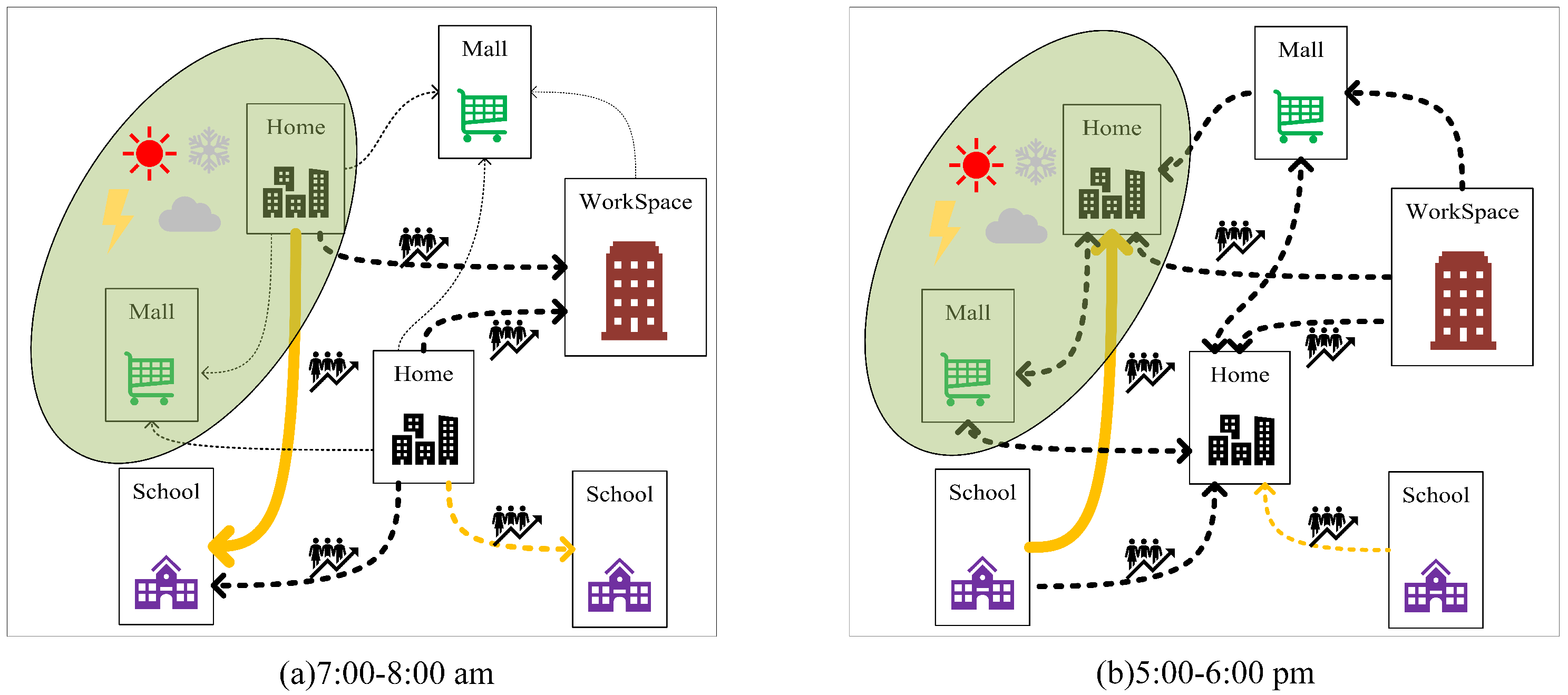

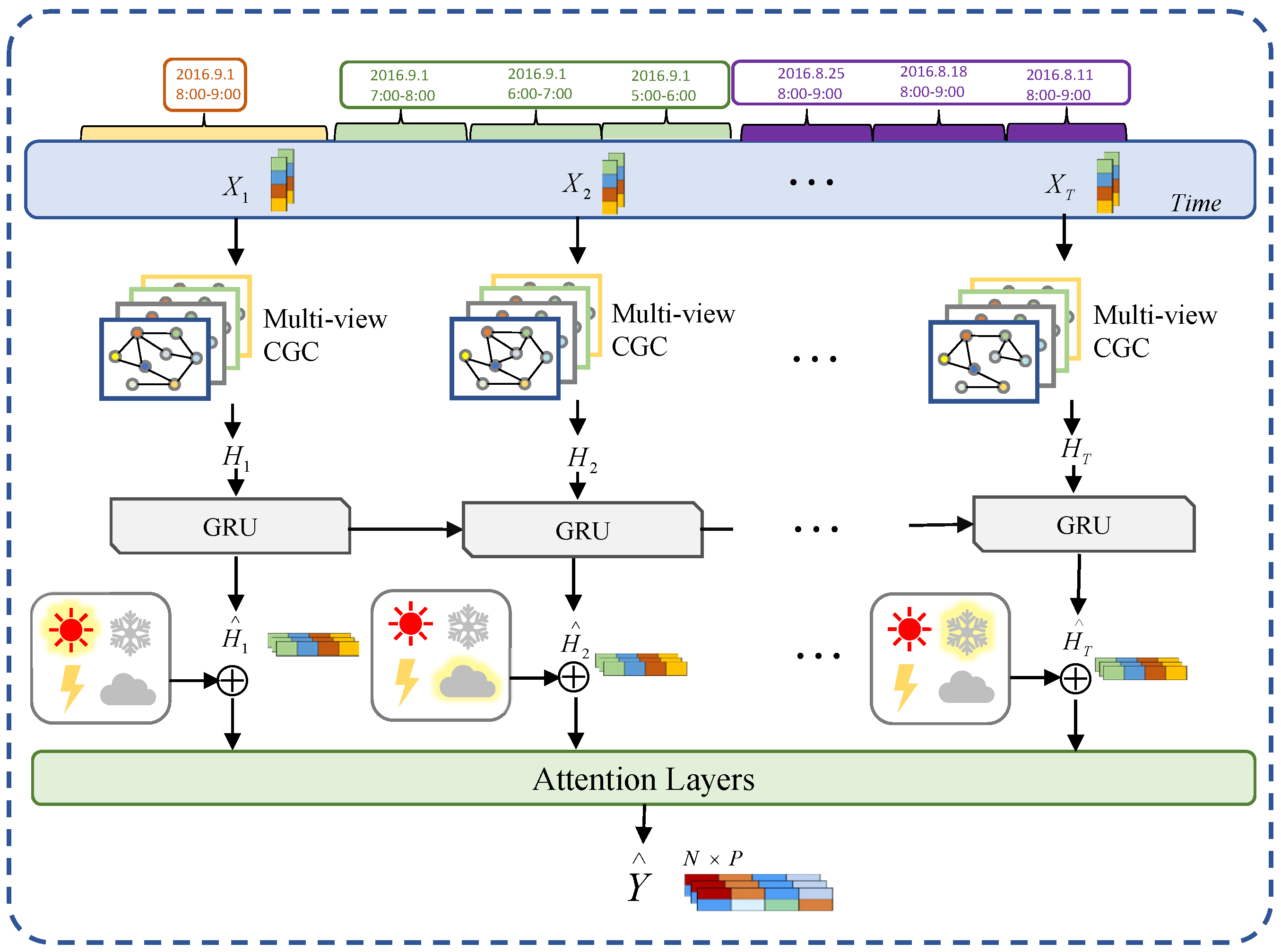
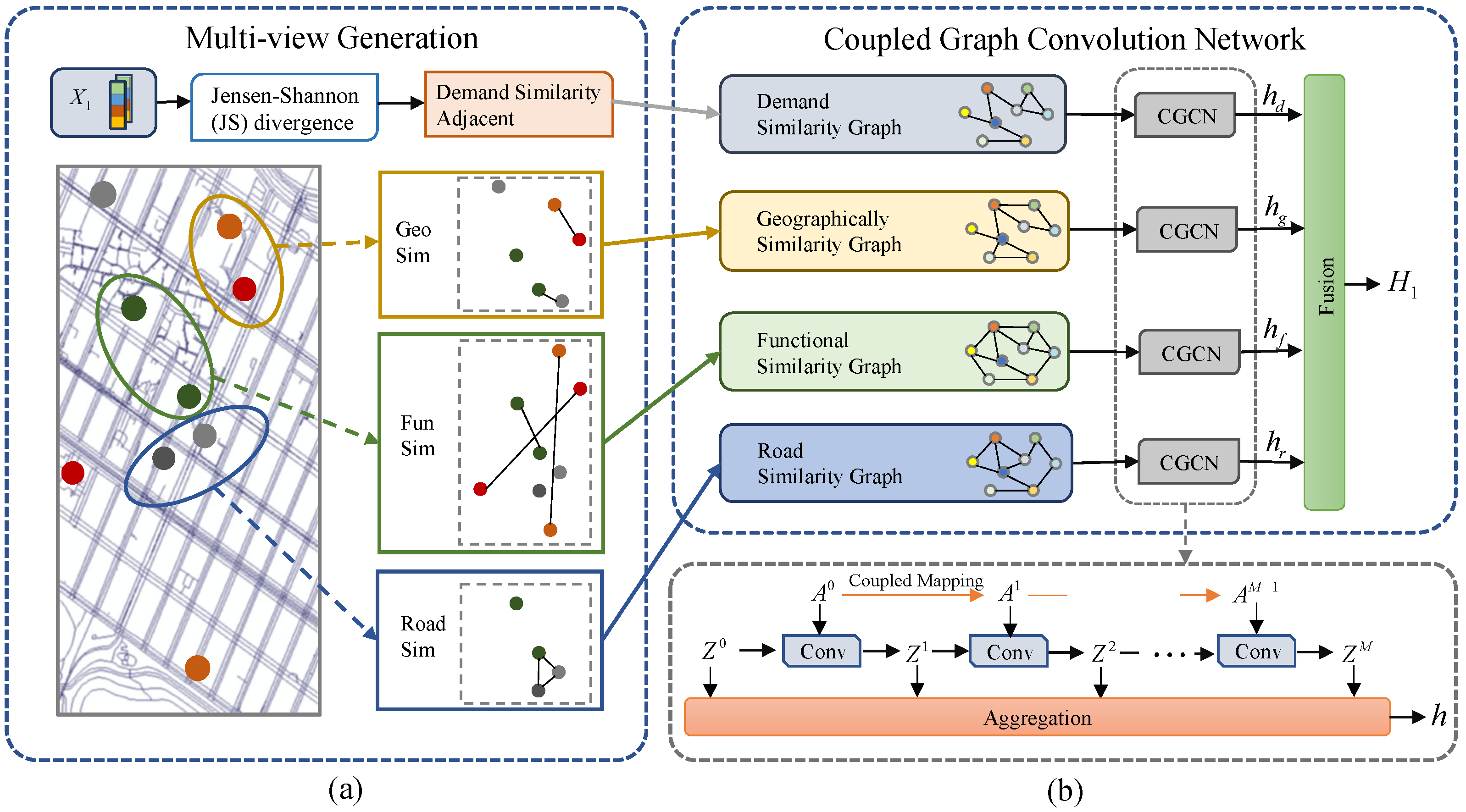
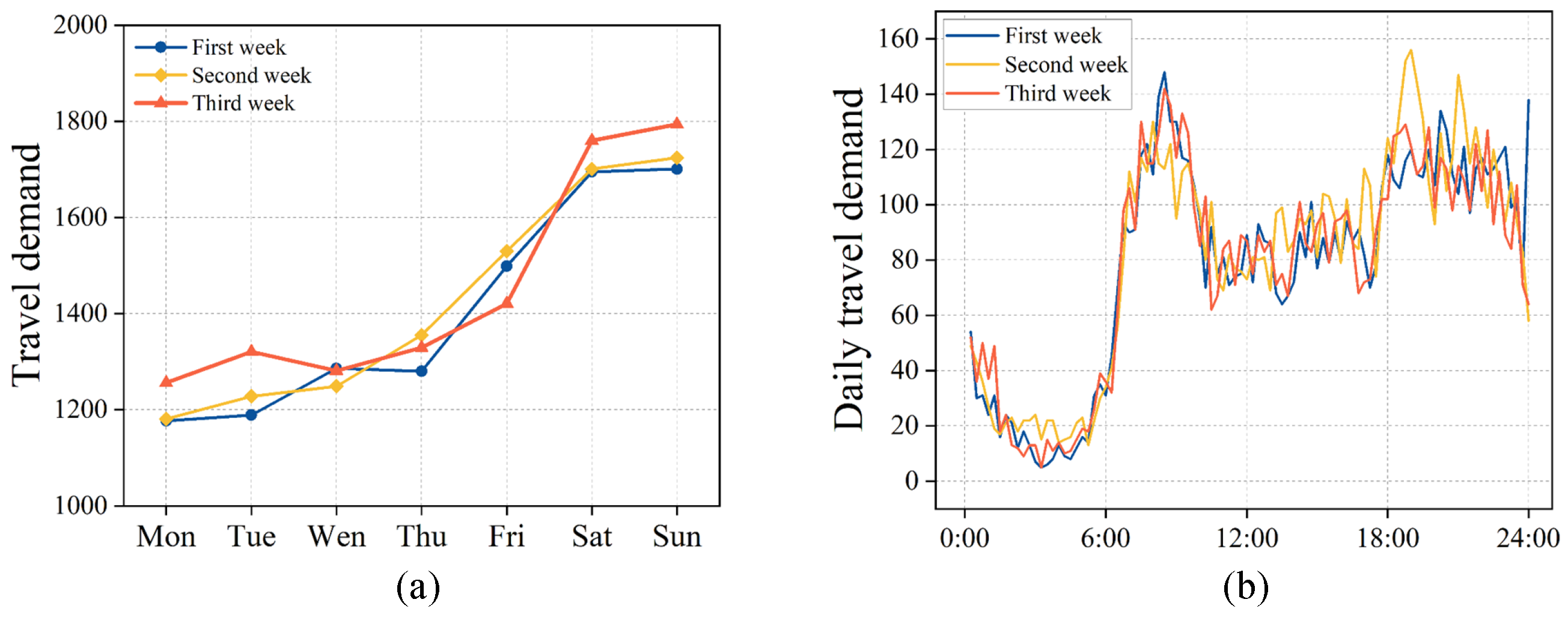







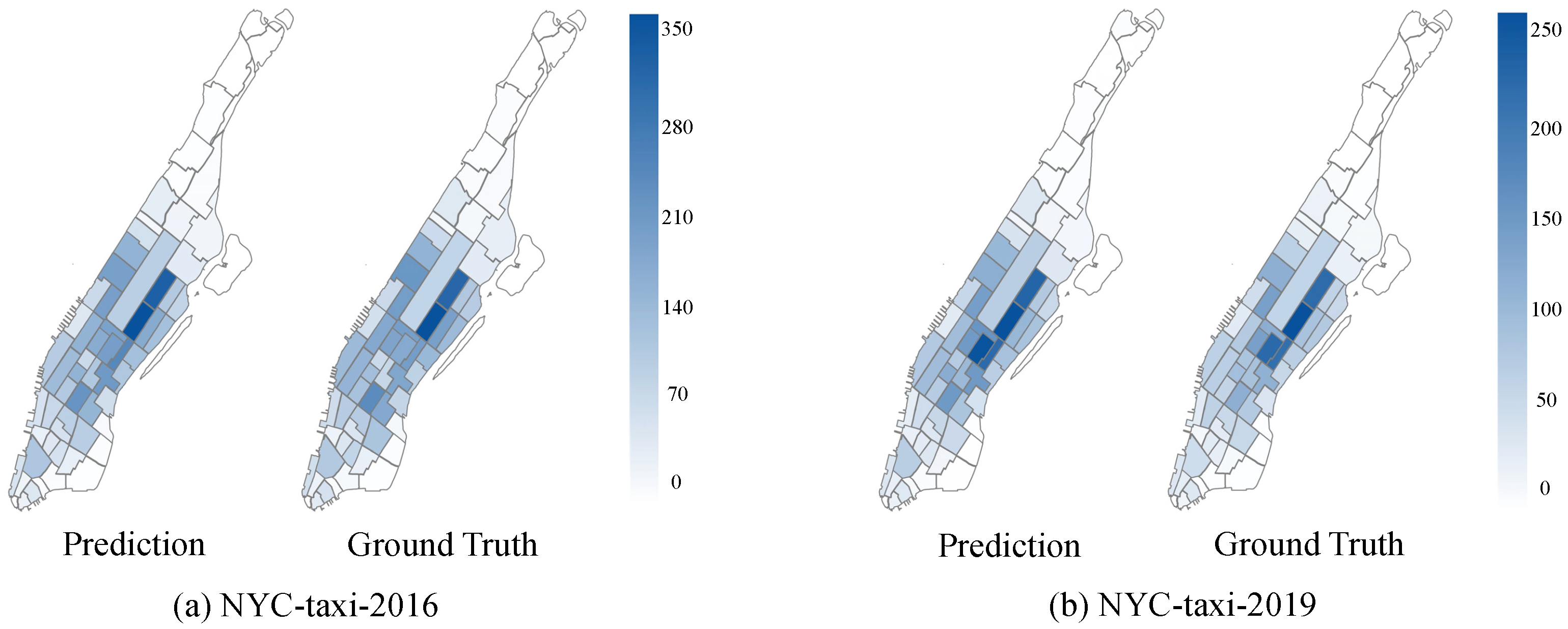
| Model | MAE | RMSE | MAPE | |||||||||
|---|---|---|---|---|---|---|---|---|---|---|---|---|
| T = 1 | T = 2 | T = 3 | T = 4 | T = 1 | T = 2 | T = 3 | T = 4 | T = 1 | T = 2 | T = 3 | T = 4 | |
| HA | 15.5656 | 15.5656 | 15.5656 | 15.5656 | 26.3609 | 26.3609 | 26.3609 | 26.3609 | 52.85% | 52.85% | 52.85% | 52.85% |
| VAR | 9.1140 | 9.6430 | 10.2674 | 10.9622 | 14.9206 | 15.8139 | 16.8368 | 17.9714 | 32.31% | 33.35% | 34.86% | 36.74% |
| ARIMA | 8.3027 | 8.9496 | 9.8732 | 10.5988 | 13.6551 | 14.3841 | 15.0756 | 15.1062 | 30.38% | 29.51% | 32.28% | 36.76% |
| GraphWaveNET | 7.2558 | 7.9336 | 8.4908 | 8.9350 | 11.4538 | 12.8381 | 13.7841 | 14.4507 | 28.77% | 30.32% | 33.28% | 36.65% |
| StemGNN | 7.8737 | 8.6559 | 9.3412 | 9.9432 | 12.4606 | 13.9908 | 15.2511 | 16.3861 | 26.99% | 28.81% | 28.59% | 29.83% |
| AGCRN | 7.4766 | 7.9428 | 8.3931 | 8.6966 | 11.8761 | 12.8451 | 13.6885 | 14.2983 | 26.74% | 26.79% | 29.76% | 28.79% |
| DGCRN | 7.2919 | 7.7324 | 8.1710 | 8.5788 | 11.4688 | 12.4485 | 13.4257 | 14.1501 | 24.65% | 26.36% | 27.78% | 29.09% |
| DMV-GCN | 7.1527 | 7.6892 | 8.0813 | 8.3983 | 11.3687 | 12.4712 | 13.1819 | 13.7580 | 23.76% | 24.28% | 24.96% | 26.30% |
| Model | MAE | RMSE | MAPE | |||||||||
|---|---|---|---|---|---|---|---|---|---|---|---|---|
| T = 1 | T = 2 | T = 3 | T = 4 | T = 1 | T = 2 | T = 3 | T = 4 | T = 1 | T = 2 | T = 3 | T = 4 | |
| HA | 9.2981 | 9.2981 | 9.2981 | 9.2981 | 16.4961 | 16.4961 | 16.4961 | 16.4961 | 60.86% | 60.86% | 60.86% | 60.86% |
| VAR | 6.9041 | 7.1414 | 7.4254 | 7.7397 | 12.6623 | 13.1045 | 13.6094 | 14.1602 | 45.46% | 47.19% | 49.40% | 52.02% |
| ARIMA | 6.1517 | 6.9229 | 7.3199 | 7.5304 | 10.3807 | 11.2033 | 11.4912 | 13.2935 | 40.73% | 49.87% | 53.42% | 46.22% |
| GraphWaveNet | 5.7631 | 6.4184 | 6.9606 | 7.4902 | 9.5184 | 10.8770 | 11.9056 | 12.8824 | 30.77% | 32.75% | 35.14% | 37.33% |
| StemGNN | 5.6223 | 5.7510 | 6.0954 | 6.4572 | 9.8931 | 10.2711 | 11.0161 | 11.7550 | 34.06% | 34.61% | 35.65% | 38.06% |
| AGCRN | 5.6107 | 5.9134 | 6.1992 | 6.4304 | 9.3818 | 10.0416 | 10.5704 | 10.9811 | 32.16% | 31.78% | 33.84% | 33.99% |
| DGCRN | 5.4037 | 5.8837 | 6.3532 | 6.9375 | 8.8506 | 9.8173 | 10.6640 | 11.6736 | 32.47% | 34.12% | 35.96% | 37.63% |
| DMV-GCN | 5.3452 | 5.7451 | 6.0053 | 6.2584 | 8.8454 | 9.6062 | 10.1059 | 10.6034 | 29.41% | 30.10% | 30.85% | 32.04% |
Publisher’s Note: MDPI stays neutral with regard to jurisdictional claims in published maps and institutional affiliations. |
© 2022 by the authors. Licensee MDPI, Basel, Switzerland. This article is an open access article distributed under the terms and conditions of the Creative Commons Attribution (CC BY) license (https://creativecommons.org/licenses/by/4.0/).
Share and Cite
Liu, Z.; Bian, J.; Zhang, D.; Chen, Y.; Shen, G.; Kong, X. Dynamic Multi-View Coupled Graph Convolution Network for Urban Travel Demand Forecasting. Electronics 2022, 11, 2620. https://doi.org/10.3390/electronics11162620
Liu Z, Bian J, Zhang D, Chen Y, Shen G, Kong X. Dynamic Multi-View Coupled Graph Convolution Network for Urban Travel Demand Forecasting. Electronics. 2022; 11(16):2620. https://doi.org/10.3390/electronics11162620
Chicago/Turabian StyleLiu, Zhi, Jixin Bian, Deju Zhang, Yang Chen, Guojiang Shen, and Xiangjie Kong. 2022. "Dynamic Multi-View Coupled Graph Convolution Network for Urban Travel Demand Forecasting" Electronics 11, no. 16: 2620. https://doi.org/10.3390/electronics11162620
APA StyleLiu, Z., Bian, J., Zhang, D., Chen, Y., Shen, G., & Kong, X. (2022). Dynamic Multi-View Coupled Graph Convolution Network for Urban Travel Demand Forecasting. Electronics, 11(16), 2620. https://doi.org/10.3390/electronics11162620







